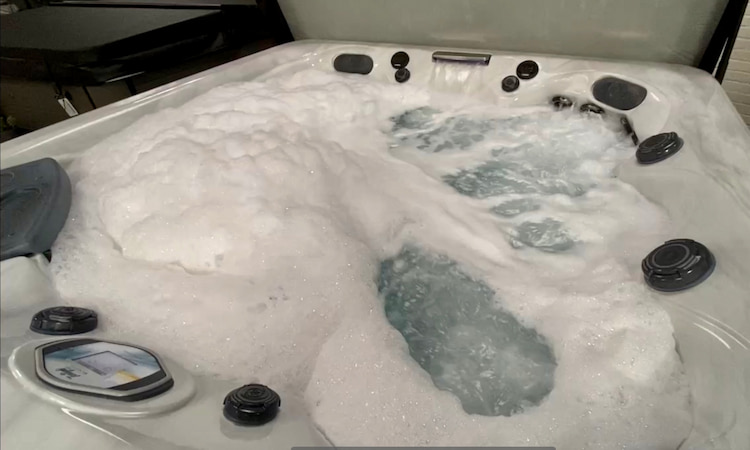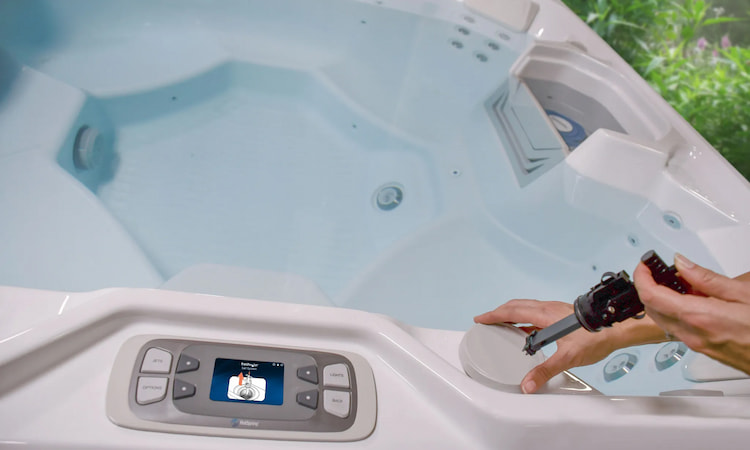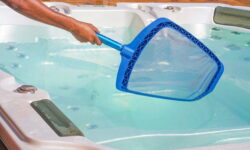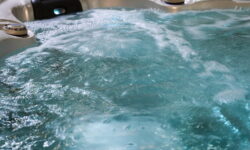You’re wondering about the foam in your hot tub, aren’t you? Is it too much? Too little? What’s normal? You’re not alone. Foam can be a common concern for hot tub owners.
A small amount of foam on the surface of your hot tub water is normal. This can be caused by things like body oils, lotions, or the chemicals used to clean the tub. However, excessive or persistent foam can indicate an imbalance in the water chemistry, such as high sanitizer levels or low pH, and may require treatment.
Don’t worry, we’ve got you covered. This guide will help you identify the causes, understand foam colors, provide tips on managing it, and teach you about regular maintenance routines.

Quick Navigation
Understanding Hot Tub Foam
The foam in your hot tub is a common occurrence, but it’s crucial to grasp what’s considered normal and what isn’t.
When you switch on the jets and a thin layer of bubbles forms on the surface, that’s normal. These bubbles should disappear shortly after turning off the jets. If they don’t, or if the foam is thick and meringue-like, it’s a sign that something isn’t right.
Primarily, foam forms when water agitation (from the jets) mixes with organic materials (like oils, lotions, and detergents) in the hot tub. The higher the concentration of these substances, the more foam you’ll see. High water hardness and a low sanitizer level can also contribute to foam development.
You’re not powerless in this situation. Regularly checking and adjusting the water chemistry, using a spa defoamer, and showering before entering the hot tub can help control foam.
Causes of Excessive Foam
Several factors can cause your hot tub to produce too much foam, and it’s essential to identify these to effectively manage the issue.
Firstly, an imbalance in your hot tub’s chemistry can lead to excessive foam. High levels of organic compounds, such as oils, lotions, and detergents, can react with the water and cause foaminess. Similarly, high pH levels can also lead to this issue. Regular testing and adjustment of your hot tub’s water chemistry can help prevent this.
Secondly, using low-quality spa chemicals can exacerbate the problem. Cheap, non-specialized products often contain fillers that can result in a surplus of foam. It’s advisable to use quality, hot tub-specific chemicals to maintain a balanced water chemistry.
Lastly, a dirty or damaged filter can also contribute to foam production. The filter’s job is to remove impurities from the water. If it’s not functioning properly, these impurities accumulate, leading to excessive foam. Regular cleaning or replacement of your hot tub’s filter can significantly reduce foam levels.
You can read a complete article about the causes of excessive foaming here.
Decoding Foam Colors
Moving on from identifying causes of excessive foam, let’s now break down what different foam colors in your hot tub might mean for you. Foam color is more than an aesthetic issue, it can be a key indicator of your tub’s health.
| Foam Color | Probable Cause | Solution |
|---|---|---|
| White/Clear | Shock, then drain and clean the tub | No action required |
| Green/Brown | Algae/Bacteria | Shock, then drain and clean tub |
| Pink/Red | Biofilm | Use an enzyme-based cleaner |
White or clear foam is typically a good sign, indicating normal operation. However, if you notice green or brown foam, this can be a sign of algae or bacteria. Immediate action is required. You’ll need to shock your tub, then drain and clean it thoroughly.
Pink or red foam can be alarming, but don’t panic. This color often signifies biofilm, a layer of bacteria that forms on surfaces that aren’t cleaned regularly. To remedy this, use an enzyme-based cleaner specifically designed to break down biofilm.
Tips for Managing Foam
Now that you’ve got the scoop on deciphering foam colors, let’s dive into some practical tips for managing hot tub foam.

Ensuring your hot tub is foam-free doesn’t have to be a chore. You can keep your spa experience relaxing and enjoyable with proper maintenance and a few preventative measures.
Here are four tips to help you manage and reduce hot tub foam:
- Regularly Test and Adjust Water Chemistry: Maintaining the right balance of pH, alkalinity, and sanitizer in your hot tub is essential. Incorrect levels can lead to excessive foam.
- Shower before Using the Hot Tub: Lotions, oils, and other personal care products can cause foam. By showering before you soak, you’ll reduce the introduction of these foam-causing substances.
- Use a Foam Reducer: If you’re already dealing with foam, a foam reducer can be a quick fix. These products break down the surface tension of the water, reducing foam.
- Regularly Clean Your Hot Tub: This includes changing the water, cleaning the filter, and wiping down the surfaces. A clean hot tub is less likely to produce excessive foam.
Regular Maintenance for Foam Prevention
To keep the foam at bay, you’ll want to make regular maintenance a priority in your hot tub care routine.
This involves regularly checking and maintaining the water chemistry, ensuring correct pH levels and adequate sanitizer. You’ll also want to clean your filters frequently, as dirty filters can contribute to foam production.
Water changes are crucial too. Even with the best care, over time, organic materials build up in the water that can lead to foam. It’s recommended that you completely drain and refill your hot tub every 3-4 months.
Don’t forget about showering before using your hot tub. Lotions, oils, and other body products can contribute to foam. A quick rinse before you dip can significantly reduce the likelihood of foam.
Lastly, invest in a good quality defoamer. These products are designed to break down the foam on contact, and regular use can help keep your hot tub foam-free.
Frequently Asked Questions
Excessive foam in your hot tub can pose health risks. It’s often a sign of high contaminant levels, which could lead to skin or eye irritation, respiratory issues, and even bacterial infections if you’re not careful.
Yes, excessive foam can harm your hot tub’s equipment. It’s not just unsightly; it can also clog filters, leading to inefficiencies or breakdowns. So, it’s important you manage and prevent foam build-up in your tub.
You should replace your hot tub water every three to four months. Consistent water changes help prevent excessive foam buildup. It’s also crucial to maintain proper chemical balance for optimal hot tub performance.
Yes, there are products specifically designed to reduce foam in hot tubs. You’ll find anti-foam chemicals at any pool supply store. Just make sure you’re following the manufacturer’s instructions when using them.
Yes, it’s possible. Foam in your hot tub can potentially cause allergic reactions. This is due to the chemicals and contaminants trapped in the foam. If you’re sensitive, it’s best to minimize foam production.
Conclusion
In conclusion, a little foam in your hot tub is normal, but too much can indicate an issue. Causes range from body oils to chemical imbalances.
Foam colors also reveal different issues. To manage foam, try reducing contaminants, adjusting chemicals, or using defoamers. Never forget the importance of regular maintenance to prevent foam build-up.





![Is Yellow Hot Tub Water Safe? [& Treatment Options] is yellow water in hot tub safe](https://hottubtales.com/wp-content/uploads/2023/10/is-yellow-water-in-hot-tub-safe-250x150.jpg)
